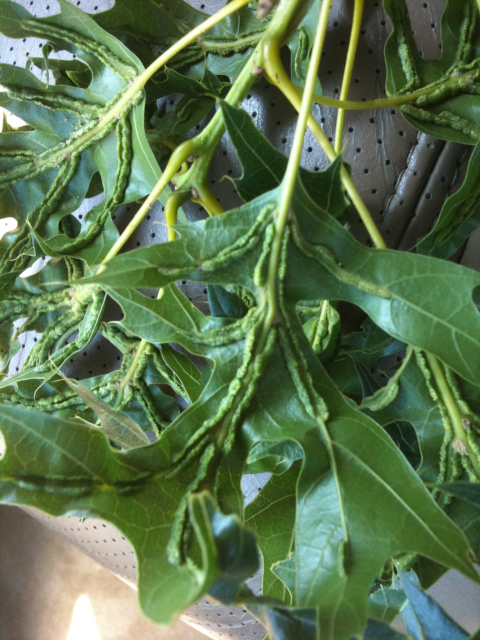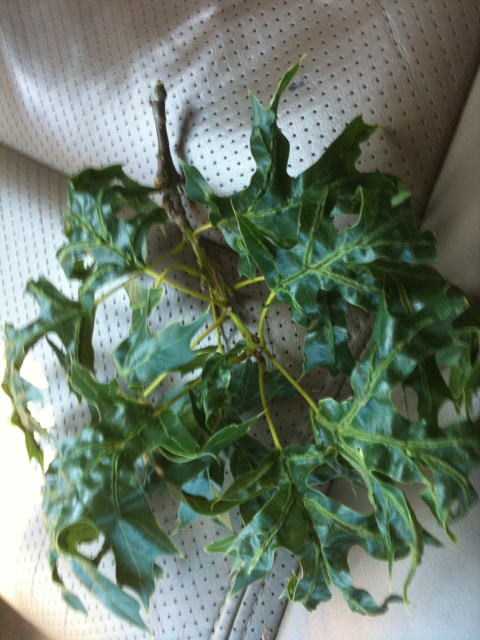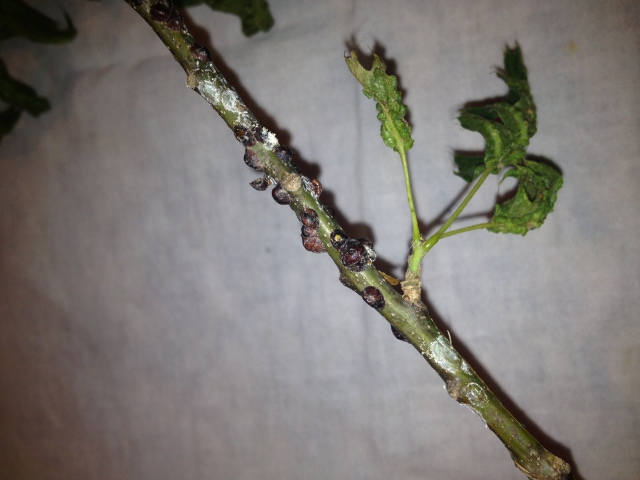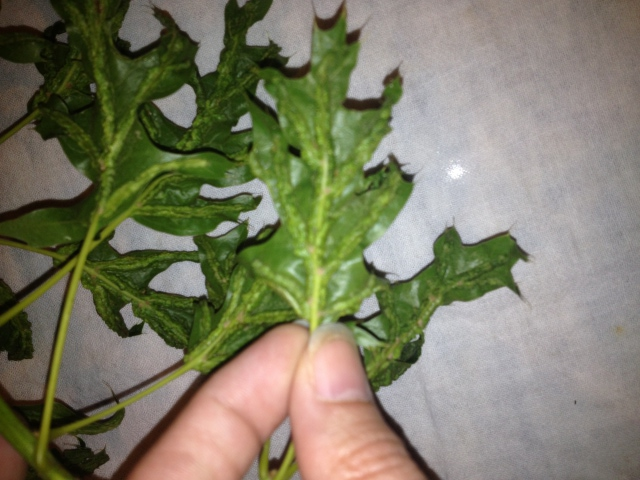Question red oak pic 2
red oak pic 2
 red oak pic1
red oak pic1
QUESTION: See attached for what appeared on my two large Red Oaks (about 5' in diameter measured 4' from ground) in the spring of 2010. At that point an arborist diagnosed this as vein pocket gall and said nothing could be done at the point we were discussing and recommended possibly spraying the tree when it was dormant. Winter of 2010/11---I forgot about the problem and didn't have it sprayed. Spring 2011 same problem and arborist said "call me in January and we'll get a plan."
February/March 2012-- arborist recommended "Arborjet injection of system insect control, Azasol folliar lawn spray under the canopies of the trees and foliar spray of Azasol at the time leaves are unfolding." This was an expensive process and came with not a lot of reassurance that it would help the problem. We drug our feet and didn't do it in the timing he recommended. Now it's May 2013 and the problem is worse than ever on of the two trees and there is only minimal evidence of this on the other tree. On the tree in question, this is throughout the tree, top to bottom. Must do something to help but want to make sure we are doing the right thing. Thoughts??
ANSWER: Well, based upon photos, it does appear to be vein pocket gall.
This is a gall caused by a tiny fly, known as a midge. http://en.wikipedia.org/wiki/Cecidomyiidae
Generally speaking while they cause terrible looking growths, we call galls, unless every leaf is covered they are not a serios risk to the tree. They do cause the impacted lease to have a reduced ability in the process of Photosynthesis.
If you break open one of the deformed areas on the leaves, you will find small midge larvae inside.
You can treat the tree to kill the larvae, but the galls will not go away this year.
Any treatment to prevent the galls must be applied prior to formation of the galls, and timing is critical. However, while treatment may be effective, is usually is impractical. Some insecticides can kill the midge at the adult stage. A systemic insecticide should in theory provide effective gall controll, but again depends upon timing and will not fix any already existing. Many prescribed treatments can be costly, and as this is normally not life threatening are not cost justified.
A chemical we have seen used is Imidicloprid, which has proved effective in killing the larvae. And in many areas can be applied by the homeowner. It will not fix the galls, but can kill the larvae. It is produced by several companies under several brand names, a common one however is produced by Bayer and sold under the Merit brand name. Check with your local landscape store, and see what products they have for soil application. The product is taken in by the root system, and as it is systemic, will travel throughout the tree and into the foliage. While it may e late in the year for you, it is typically the most cost effective solution,
Azasol is actually a Arborjet product, which is based upon azadirachtin, another effective chemical that could be used, but not likely available in your local store.
Some suppliers are here
http://arborjet.com/AzaSol%20Distributors%20-%20Master%2003112013.pdf
http://growplantsamerica.com/azasol.html
Azasol can be used as a soil drench, but I have never seen it used for controlling midges, that is not to say it is not effective, I would need to call Arborjet to obtain their opinion. We can not use, so I am not totally familiar with its results.
Here is a brochure for your review.
http://www.azasol.com/pdfs/azasolbrochure.pdf
Azasol is also not available or legal is some states, there are several lists showing where it can not be used, look at the lower portion of this page for listing.
http://www.thetreegeek.com/products/aza-sol/
You are limited however to a soil drench if you wish to do yourself, or a direct injection if you wish to hire somebody. Personally I think an injection is more effective, but also more costly. If the infestation does not cover all leaves, the trees life is likely not at risk, and you may not wish to spend the dollars at this time, as the existing galls will not disappear.
---------- FOLLOW-UP ----------
 redoak2013.2
redoak2013.2  redoak2013.1
redoak2013.1
QUESTION: Thank you sooo much for your thorough, thoughtful answer. I had my doubts that I would actually get a response and was so pleasantly surprised when I did. Thank you.
As a follow up, the infestation does cover all leaves--every.single.leaf. throughout the very large tree. In addition, the leaves are a bit more damaged than the first pictures I sent reveal (those I took several years ago.) Now the leaves are even more curled and damaged from the gall. I am sending additional pictures I have just taken this morning. Is the wart-like growth on the stem caused from the larvae as well?
I understand that nothing will make the gall disappear this growing season. Because it is "normally not life threatening" we do not want to spend high dollars to treat. However, since this is the fourth growing season that it has appeared and the damage appears worse this year than in previous years I do want to do something. We may try to treat it ourselves the first go around if the proper products are available to us (thank you for the links!) and might consider the injection if I can find a professional to do it at a reduced price than what I was quoted. Since timing is critical, exactly when would you recommend treating? If it matters, we are located in the north Texas area (Dallas County.) Just want to do whatever is needed if the tree's life and health are at risk. It is a central feature of our landscape.
Thanks again for your time and response!
AnswerI will answer this in a couple of messages, being a warm Saturday, I am answering on a brief break.
The growth on the twigs is a type of gall, you will likely be surprised that oaks host more gall types than any other plant we have in North America. There are over 1,000 galls we know about in North America, and over half of these are associated in one way or another with the oak. Oaks have galls on the leaves, twigs, roots, flowers and even the acorns. Most by far are associated with the leaves with twigs being second.
Does the growth on the twig have any substance that is oozing out, or what are they like inside if your break one? How many twigs do these appear on?
These are quite possibly caused by a gall wasp, these are a tiny wasp and is actually the most common gall insects and they can affect leaves, stems and twigs. Oaks are one of their most frequent hosts.
When a gall wasp invades a leaf, the results are different than you had shown, and are generally circular areas which are impacted.
Treatment of one invader that is also on leaves would also treat anything on the twigs. But if all leaves are impacted, and twigs also have issues, the overall tree may in time become seriously weakened. Trees do have an enormous amount of stored energy, and can go for a surprisingly long time, but do eventually wear down as does anything.
The issues then become potential to get very serious issues such as Hypoxylon Canker, which only normally impacts weakened trees.
I will follow up with another note later.









